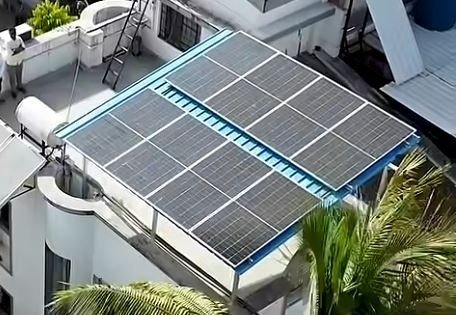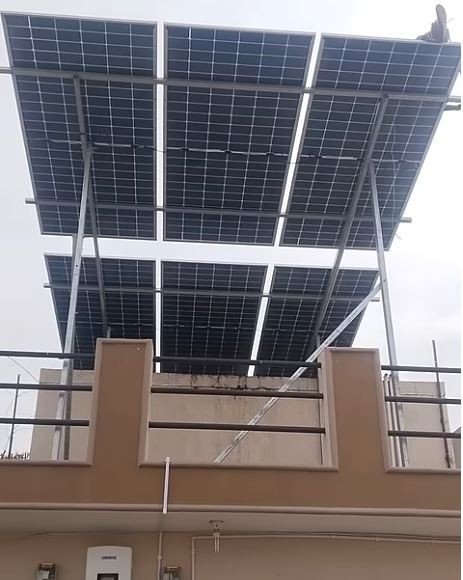
“Everything You Need to Know About PM Surya Ghar Muft Bijli Yojana
Table of Contents
“Everything You Need to Know About PM Surya Ghar Muft Bijli Yojana – A Complete Solar Scheme Breakdown”
In a country where electricity is not just a utility but a necessity for daily life, the Government of India has taken a bold step to bring clean, affordable, and free electricity to the doorsteps of common citizens. The launch of the PM Surya Ghar: Muft Bijli Yojana marks a significant leap toward energy independence for millions of Indian households.
Here’s a detailed look at what this scheme is, how it works, and why it matters.
✅ What is PM Surya Ghar Muft Bijli Yojana?
The PM Surya Ghar Muft Bijli Yojana is a central government initiative aimed at promoting the installation of rooftop solar panels in residential homes across India. It enables families to generate their own electricity using solar energy, helping them save on electricity bills and even earn from the excess power they generate.
The most attractive feature? Households will receive up to 300 units of electricity every month – completely free of cost.
This initiative is part of India’s broader push to boost renewable energy and reduce dependence on fossil fuels.
🌟 Key Features and Objectives of the Scheme
Let’s look at the main highlights and what the government aims to achieve:
🔹 1. Free Electricity
- Households that install solar panels under this scheme can get up to 300 units of electricity per month free.
- This can significantly reduce or even eliminate monthly electricity bills.
🔹 2. Direct Subsidy to Households
- The central government offers a direct subsidy, which is deposited in the applicant’s bank account after successful installation and inspection.
- Subsidy amounts:
- ₹30,000 per kW for up to 2 kW
- ₹18,000 per additional kW for 3 kW systems
- Maximum subsidy of ₹78,000
🔹 3. Simplified Online Application
- A user-friendly portal has been launched: https://pmsuryaghar.gov.in
- The entire process, from registration to installation and subsidy claim, is 100% online.
🔹 4. Focus on Middle- and Lower-Income Families
- The scheme prioritizes financially weaker and middle-class families, giving them an opportunity to adopt solar energy without a heavy investment.
🔹 5. Net Metering Facility
- Households can use the power they generate and sell the surplus back to the electricity grid.
- This can also provide an additional income stream for families.
🔹 6. Encouragement to Self-Sustainability
- The scheme promotes the idea of “generate your own power”, reducing dependency on traditional energy sources.
🔆 How PM Surya Ghar Yojana Promotes Solar Energy in India
India is blessed with abundant sunlight throughout the year. But despite this, rooftop solar adoption has been relatively low, mainly due to high installation costs and lack of awareness.
Here’s how this scheme is changing the game:
- Making Solar Affordable: With heavy subsidies and free electricity, the scheme removes the cost barrier that previously kept solar panels out of reach for many families.
- Creating Awareness: The launch of a dedicated portal and national promotion campaigns is helping people understand the long-term benefits of solar energy.
- Boosting Domestic Manufacturing: Increased demand for solar panels and equipment is expected to boost Make in India efforts and create new job opportunities.
- Reducing Carbon Emissions: As more homes switch to solar, the country’s carbon footprint will reduce, contributing to global climate goals.
💰 Budget Allocation and Target Beneficiaries
The Union Government has allocated a budget of ₹75,021 crore for this ambitious scheme. This budget will cover:
- Subsidies for the installation of rooftop solar systems
- Awareness campaigns
- Infrastructure support for vendors and state electricity boards
🎯 Target:
- 1 crore households across India will be covered in the first phase.
- Focus on urban and semi-urban homes that have rooftop space and consistent grid connectivity.
Prime Minister Narendra Modi has stated that this scheme is a “sunlight-powered revolution” aimed at both economic relief for families and environmental sustainability for the nation.
Certainly! Here’s a detailed, friendly, and blog-style news article covering the Eligibility & Application process for the PM Surya Ghar Muft Bijli Yojana, written in a plagiarism-free manner, ideal for a news blog or informational portal.
⚡ PM Surya Ghar Muft Bijli Yojana: Eligibility & Easy Application Guide for Indian Households
If you’re wondering who can apply, how to apply, what documents are needed, and what mistakes to avoid, you’re in the right place. Here’s everything you need to know — explained in a simple, friendly way.
✅ Who Can Apply for PM Surya Ghar Muft Bijli Yojana?
This scheme is specially designed to benefit residential households across India. To be eligible, the applicant must meet the following conditions:
✔ Eligibility Criteria:
- Must be an Indian citizen.
- Must own a house (either individually or jointly) with suitable rooftop space for installing solar panels.
- Must have a valid electricity connection in their name from the local DISCOM (electricity distribution company).
- Priority is given to middle-class and lower-income families.
- Households must not have already availed a subsidy under another rooftop solar scheme.
🔎 Note: Tenants living in rented homes are not eligible, unless they own the roof and the power connection.
🖥️ Step-by-Step Guide to Apply Online

The government has made the application process very easy and completely online through the official portal: https://pmsuryaghar.gov.in
📝 Follow These Steps:
🔹 Step 1: Register Online
- Visit the official portal: https://pmsuryaghar.gov.in
- Select your State and DISCOM
- Enter your Consumer Number and Mobile Number
- Verify via OTP and create your account
🔹 Step 2: Login and Apply
- Log in with your registered details
- Fill the application form with property and electricity details
- Upload the necessary documents (see below)
🔹 Step 3: Choose a Vendor
- Choose an approved empanelled vendor listed in your area on the portal
- Finalize the quote and system size (1kW, 2kW, 3kW, etc.)
🔹 Step 4: Installation and Inspection
- The vendor installs the system
- Your DISCOM inspects the installation and installs a net meter
🔹 Step 5: Get Your Subsidy
- After inspection, upload the final installation certificate
- Subsidy will be directly credited to your bank account within a few weeks
📄 List of Required Documents for Application
Here’s a quick checklist of what you need to keep ready while applying:
| Document | Purpose |
| ✅ Aadhaar Card | Identity verification |
| ✅ Electricity Bill (latest) | DISCOM and consumer details |
| ✅ Property Ownership Proof (like property tax receipt, sale deed, or house patta) | Proof of rooftop ownership |
| ✅ Passport-size Photo | Personal identification |
| ✅ Bank Passbook / Cancelled Cheque | For direct subsidy transfer |
| ✅ Mobile Number Linked with Aadhaar | For OTP and portal registration |
🔐 Pro tip: Make sure your name on the electricity bill matches your Aadhaar or ownership documents to avoid delays.
⚠️ Common Mistakes to Avoid While Applying
Many applications get rejected or delayed because of avoidable errors. Here’s what to watch out for:
❌ Don’t:
- Upload unclear or mismatched documents (e.g., name mismatch on Aadhaar and electricity bill)
- Choose unregistered or non-empanelled vendors
- Skip the final inspection and net meter request
- Enter wrong consumer number or DISCOM name
- Forget to update bank details correctly
✅ Do:
- Cross-check all entered information before submitting
- Choose vendors only from the official empanelled list
- Regularly check your application status on the portal
Certainly! Here’s a detailed, blog-style news article written in a friendly, plagiarism-free tone, focusing on the financial benefits and subsidies under the PM Surya Ghar: Muft Bijli Yojana — perfect for a news blog or informational website.
Financial Benefits & Subsidy Explained in Simple Terms
With rising electricity bills and the growing cost of living, the Indian government’s PM Surya Ghar: Muft Bijli Yojana is a welcome relief for families looking to cut costs and go green. One of the biggest attractions of the scheme is the generous subsidy and financial support offered for installing rooftop solar panels.
But how much money can you really save? What’s the exact subsidy amount? And does it cover everything from purchase to maintenance?
Let’s break it down in a way that’s easy to understand.
💰 How Much Subsidy Will You Get Under This Scheme?
Under this scheme, the government offers direct financial assistance to help households install rooftop solar systems. The subsidy is transferred directly into the beneficiary’s bank account after successful installation and verification.
📊 Subsidy Details:
- ₹30,000 per kW for the first 2 kW
- ₹18,000 per kW for the next 1 kW (i.e., from 2 kW to 3 kW)
- Maximum subsidy capped at ₹78,000 per household
✅ Example:
If you install a 3 kW system, the subsidy will be:
- ₹30,000 × 2 = ₹60,000 (for first 2 kW)
- ₹18,000 × 1 = ₹18,000 (for the third kW)
Total: ₹78,000
This financial assistance significantly reduces the upfront cost and makes rooftop solar affordable for the middle and lower-income groups.
📉 Monthly and Annual Savings by Installing Rooftop Solar
Installing a rooftop solar system not only reduces your reliance on the power grid but also leads to massive long-term savings on your electricity bills.
💵 Estimated Monthly Savings:
- A 1 kW solar system can generate ~100–120 units/month
- A 3 kW system can generate ~300–350 units/month
If you’re currently paying ₹6–8 per unit, your monthly savings could be:
| System Size | Units Saved | Monthly Savings | Annual Savings |
| 1 kW | 100 units | ₹600–₹800 | ₹7,200–₹9,600 |
| 2 kW | 200 units | ₹1,200–₹1,600 | ₹14,400–₹19,200 |
| 3 kW | 300+ units | ₹1,800–₹2,400 | ₹21,600–₹28,800 |
👉 Plus, under this scheme, you get up to 300 units of electricity completely free every month!
📦 Breakdown of Financial Support for 1kW, 2kW, and 3kW Systems
Here’s a quick glance at how much support you’ll get depending on the solar system size you choose:
| System Capacity | Total Subsidy | Avg. System Cost (Before Subsidy) | Final Cost After Subsidy |
| 1 kW | ₹30,000 | ₹60,000 – ₹70,000 | ₹30,000 – ₹40,000 |
| 2 kW | ₹60,000 | ₹1,10,000 – ₹1,30,000 | ₹50,000 – ₹70,000 |
| 3 kW | ₹78,000 | ₹1,60,000 – ₹1,80,000 | ₹82,000 – ₹1,02,000 |
📌 Note: Prices may vary slightly depending on the vendor, location, and quality of equipment.
🛠️ Does It Cover Installation & Maintenance Costs?
Yes — to a large extent!
🔧 What’s Covered:
- Solar panel cost
- Inverter
- Wiring and mounting structures
- Installation labor charges
- Net meter connection
- Inspection and approval charges
These are all included in the system cost, which the subsidy helps reduce.
❌ What’s Not Fully Covered:
- Maintenance after 5 years
- Battery backup systems (if you opt for off-grid)
However, most vendors offer a 5-year maintenance warranty as part of the package. After that, basic cleaning and checks are usually affordable and infrequent.
Absolutely! Here is a detailed, beginner-friendly, and plagiarism-free news article in a friendly tone, covering the technical insights of the PM Surya Ghar Muft Bijli Yojana — perfect for blogs, awareness platforms, or educational websites.
🔧 Technical Insights of PM Surya Ghar Muft Bijli Yojana
The PM Surya Ghar: Muft Bijli Yojana is not just a government subsidy scheme — it’s a solar energy revolution for Indian homes. While the financial benefits are well-known, many people still have questions about the technical side of it. What exactly is a rooftop solar system? How much electricity can it generate? And what is this “net metering” everyone keeps talking about?
☀️ What is a Rooftop Solar System? (Explained for Beginners)
A rooftop solar system is a setup that allows you to generate electricity using sunlight — right from your own roof.
🧩 It includes:
- Solar panels: These capture sunlight and convert it into electricity.
- Inverter: Converts DC power (from the panels) into AC power (which your home appliances use).
- Mounting structure: Metal frame to hold the panels in place.
- Wiring and safety equipment: For safe electricity flow.
- Net meter: Measures how much electricity you use vs. how much you send back to the grid.
Once installed, the system runs automatically during daylight hours, and your appliances draw power from solar energy instead of the grid.
🌞 In short: It turns your rooftop into a mini power plant!
⚡ How Much Electricity Will You Get from a 1kW Solar Panel?
One of the most common questions is, “How much power can I generate with solar panels?”
Here’s a simple breakdown:
| Panel Size | Average Daily Output | Monthly Output | Annual Output |
| 1 kW | 4–5 units/day | ~100–120 units | ~1,200–1,500 units/year |
So if you install a 3 kW system, you could generate 300–360 units/month, which is just right for most small and medium-sized homes in India.
Of course, the actual output depends on:
- Your location (sunlight hours)
- Angle and direction of panel placement
- Weather conditions (sunny vs cloudy days)
- Panel quality
☀️ India, especially central and southern states, gets abundant sunlight, making solar energy a smart and practical choice.
🔄 How Net Metering Works with PM Surya Ghar Scheme
Net metering is a super useful feature that makes solar energy even more rewarding.
Here’s how it works:
- During the day, your solar panels generate electricity.
- If you’re not using all of it, the extra units are sent to the electricity grid.
- Your net meter tracks:
- Units consumed from the grid
- Units sent back to the grid
- At the end of the billing cycle, you pay only for the net usage (i.e., what you used minus what you gave back).
✅ If you export more than you import, you may even get compensation or credits from your DISCOM.
🔌 Example:
- You generate 120 units, but use only 90
- 30 units are sent to the grid
- You pay nothing — and may even earn credits!
It’s like a give-and-take relationship between your house and the power company.
🌡️ Solar Panel Types and Their Efficiency in Indian Climate
India’s climate is ideal for solar, but choosing the right type of solar panel is important to get the most out of your system.
🧪 Common Types of Solar Panels:
| Panel Type | Efficiency | Best For | Notes |
| Monocrystalline | 18–22% | Urban rooftops with limited space | Slightly more expensive, highly efficient |
| Polycrystalline | 15–17% | Semi-urban or rural homes | Affordable, slightly lower efficiency |
| Thin-Film | 10–12% | Large open spaces (not rooftops) | Lightweight but low efficiency |
🔥 Performance in Indian Weather:
- Most solar panels work very well in Indian heat and sunlight.
- Monocrystalline panels are better in hot and low-light conditions.
- Polycrystalline is more than enough for average households.
- Panels are designed to withstand dust, heat, and rain — with a lifespan of 20–25 years!
🧼 Just keep them cleaned once a month, and they’ll keep your home powered for decades.
Benefits for Rural Homes, Urban Families & Farmers – A Closer Look with Telangana Success Stories
The PM Surya Ghar: Muft Bijli Yojana is more than just a solar subsidy scheme — it’s a nation-wide movement to bring clean, free, and self-sustained electricity to the doorsteps of ordinary Indians.
While the scheme is uniform in policy, its impact varies across regions and social categories. From rural villages to urban rooftops, and even agricultural lands, the scheme is creating real change.
Here’s a region-wise and category-focused look at how different segments of Indian society are benefiting from the solar revolution — with a special highlight on success stories from Telangana.
🌾 How This Scheme Benefits Rural Households
For rural India, electricity access is still inconsistent in many areas. Frequent power cuts, low voltage, and high bills often burden villagers. That’s where rooftop solar under this scheme becomes a game-changer.
✅ Key Benefits for Rural Families:
- Reliable Power Supply: Solar provides consistent electricity even in areas with grid instability.
- Cost Savings: Up to 300 units/month free power can cover basic needs like fans, lights, mobile charging, TVs, etc.
- Independence: Villagers can reduce dependency on erratic grid supply and expensive diesel generators.
- Women Empowerment: Solar-powered homes enable better lighting, appliance use, and safer environments for women and children.
🪔 Imagine a rural household that used to depend on kerosene lamps now enjoying free electricity from the sun — that’s true progress!
🏙️ Special Focus: Benefits for Urban Middle-Class Families
Urban middle-class families often face high electricity bills due to the usage of ACs, geysers, refrigerators, and other power-hungry appliances. This scheme offers them huge monthly savings without a heavy upfront cost.
🌇 Advantages for Urban Homes:
- Free Monthly Usage: Up to 300 units/month of free electricity means monthly savings of ₹1,500–₹2,000.
- Smart Investment: With subsidies up to ₹78,000, a solar setup becomes affordable for salaried families.
- Property Value Boost: Solar-equipped homes are future-ready and have higher resale value.
- Net Metering: Any unused power gets sent to the grid, earning credits or savings on future bills.
🏡 A 3BHK home in Hyderabad or Delhi can easily cover most of its power needs with a 3 kW system. It’s eco-friendly, economical, and practical.
🚜 How Farmers Can Use PM Surya Ghar Yojana for Pump Sets
While the scheme is primarily designed for residential rooftops, its indirect benefits to farmers are worth noting — especially those who live near their fields and use electric pump sets.
👨🌾 Possible Use Cases for Farmers:
- Solar Panels on House Roofs: Farmers can install solar on their home rooftops and use the savings to reduce the burden of electricity costs for pump sets.
- Battery Storage + Water Pumping: In some cases, solar panels can be used to charge batteries, which then run low-power DC water pumps during the day.
- Daytime Farming Operations: Lights, fans, mobile charging, and even cold storage at home can now run on free solar energy.
- Future Integration: With future government support, solar + water pump integration may expand under similar schemes.
While not directly targeted at field installations, the scheme empowers farming families to redirect saved electricity costs toward agricultural productivity.
📍 Case Study: Success Stories from Telangana
Telangana, a state already at the forefront of solar adoption, has seen early success stories under the PM Surya Ghar Yojana. Here are a few real-life examples:
🔆 A Family in Karimnagar Saves ₹2,000 Monthly
- Mr. Ramesh, a school teacher, installed a 3 kW rooftop solar system.
- His monthly electricity bill dropped from ₹2,300 to under ₹200.
- With a subsidy of ₹78,000, his net investment paid off in just 3 years.
🔆 Mahbubnagar Farmer Powers Home and Cattle Shed
- A farmer installed a 2 kW system on his home.
- He powers fans, lights, and even a small milking machine in his cattle shed.
- His family now enjoys uninterrupted power during hot afternoons.
🔆 Apartment Residents in Hyderabad Collaborate
- In a gated community, 10 residents collectively applied for rooftop solar.
- Each household now saves an average of ₹1,000 per month.
- The society has plans to expand the system to cover water motors and common lighting.
These stories prove that with the right awareness and initiative, the scheme can transform everyday life in both urban and rural Telangana.
Impact, Analysis & India’s Path to a Solar Future
With the launch of the PM Surya Ghar: Muft Bijli Yojana, India has taken one of its most ambitious steps yet toward clean, affordable, and self-sustained electricity for every home. While the scheme focuses on providing up to 300 units of free electricity per month to eligible households, its real impact is far greater than just savings.
In this article, we look at the bigger picture: What will this scheme mean for India by 2030? How does it support our renewable energy mission? And how does it stack up against previous solar subsidy efforts?
Let’s dive into the impact and analysis.
📉 Expected Impact on India’s Electricity Bills by 2030
Electricity prices in India have been steadily increasing, especially in urban and semi-urban areas. With more appliances in every home, the average household power consumption is growing rapidly. By 2030, this trend will only intensify.
Here’s how the scheme changes that:
- With over 1 crore households expected to get rooftop solar panels under the scheme, electricity demand from traditional sources will significantly reduce.
- An average household could save ₹1,500–₹2,500/month in electricity bills.
- Nationwide, this could result in annual consumer savings of over ₹15,000–₹20,000 crore by 2030.
🌞 That’s money saved straight into the pockets of ordinary Indian families.
Plus, reduced demand on state electricity boards could lead to less load shedding and better quality power supply.
🌍 How This Scheme Supports India’s Renewable Energy Goals
India has set a bold goal: achieving 500 GW of non-fossil fuel capacity by 2030 and becoming net zero by 2070. Rooftop solar is a key part of that mission.
The PM Surya Ghar Yojana contributes by:
- Promoting decentralized energy production, reducing pressure on central grids.
- Helping achieve the 40 GW rooftop solar target, which has seen slow progress until now.
- Encouraging citizen participation in clean energy, turning homes into micro power plants.
- Reducing the use of coal-based power plants — still a major source of emissions in India.
By making solar affordable and accessible, this scheme moves India closer to a green energy economy.
🔄 Comparison with Previous Solar Subsidy Schemes
Before PM Surya Ghar, there were other government schemes like:
- Grid-Connected Rooftop Solar Programme (Phase I & II)
- State-level solar subsidies
- KUSUM scheme (for farmers and solar pumps)
What Makes PM Surya Ghar Different?
| Feature | Previous Schemes | PM Surya Ghar Yojana |
| 🎯 Targeted Users | Mixed (residential + commercial) | Residential households only |
| 💰 Subsidy Amount | ~30–40% (variable) | Up to ₹78,000 (fixed & direct) |
| 🧾 Application | Offline or semi-digital | 100% online via pmsuryaghar.gov.in |
| 🔌 Net Metering | Complex or optional | Integrated & promoted |
| 🏡 Focus | General awareness | Rural + middle-class families |
| 🏦 Payment | Indirect or delayed | Direct bank credit post-installation |
In short, PM Surya Ghar Yojana is people-first, digital, transparent, and designed to actually reach the common man — not just urban elites.
🌱 How It Helps Reduce Carbon Footprint
Electricity generation is one of the largest contributors to carbon emissions in India, mainly due to coal-fired power plants. Every unit of electricity generated from solar instead of coal reduces pollution.
Environmental Impact of 1 kW Solar System:
- Saves up to 1,500 units of grid electricity per year
- Prevents 1.2–1.5 tons of CO₂ emissions annually
- Lasts for 20–25 years, multiplying the benefit long-term
Now imagine this being implemented in 1 crore households:
- That’s 1.5 crore tons of carbon saved every year
- Equivalent to planting 6 crore trees annually
🌳 Not only does the scheme help people save money — it also helps India breathe easier and positions us as a global leader in sustainable living.
FAQs, Rejection Help, Tracking, and Solar Troubleshooting
The PM Surya Ghar: Muft Bijli Yojana has sparked interest across India with its promise of up to 300 units of free electricity per month through rooftop solar power. While the benefits are huge, people often have questions, doubts, and technical issues—especially during and after the application process.
If you’re planning to apply or already did, this guide answers the most frequently asked questions, and offers easy solutions if you hit a snag.
🙋 Top 10 Frequently Asked Questions About PM Surya Ghar Scheme
Here are the top FAQs people across India are asking — answered in simple language:
1. Who is eligible for this scheme?
Any Indian resident who owns a home with a valid electricity connection and rooftop space can apply. Priority is given to middle- and lower-income households.
2. How much subsidy will I get?
- ₹30,000 per kW for the first 2 kW
- ₹18,000 per kW for the next 1 kW
- Maximum subsidy: ₹78,000
3. Is the subsidy given upfront or after installation?
The subsidy is given after successful installation and inspection, and is credited directly to your bank account.
4. Can tenants apply for the scheme?
No. Only property owners (or co-owners) with the electricity bill in their name can apply.
5. Where can I apply?
Online only at the official portal: https://pmsuryaghar.gov.in
6. How long does it take for installation and approval?
Usually between 30 to 60 days, depending on local vendor and DISCOM availability.
7. Is net metering mandatory?
Yes. Net metering is part of the scheme and helps track electricity usage vs. generation.
8. Can I choose any vendor?
No. You must choose a vendor empanelled on the portal in your DISCOM area.
9. Do I need batteries?
Not necessarily. The system is grid-connected, so power comes from solar during the day and grid at night.
10. Will my rooftop get damaged?
No. Panels are installed on mounting structures, and vendors ensure proper waterproofing and safety.
❌ What to Do If Your Application Is Rejected?
If your application for the PM Surya Ghar scheme was rejected, don’t worry — in many cases, it can be corrected and resubmitted.
🔎 Common Reasons for Rejection:
- Mismatch in Aadhaar and electricity bill name
- Incomplete documents or blurred uploads
- Not selecting the correct DISCOM
- Applying with an ineligible property (like rental)
🛠️ What You Can Do:
- Login to the portal and check the exact rejection reason under your application status.
- Update or correct the required documents.
- Resubmit your application after corrections.
- If unclear, contact your local DISCOM or call the helpline on the official site.
📞 You can also reach out via the official Grievance Redressal section on the portal for help.
🔍 How to Track Your Application Status Online
You can easily track your application status step-by-step via the official portal.
📲 Step-by-Step Tracking Guide:
- Visit: https://pmsuryaghar.gov.in
- Click on “Login” (top right)
- Enter your mobile number and OTP
- Go to “My Applications” section
- View your application status:
- Submitted
- Under Review
- Approved
- Installation in Progress
- Inspection Pending
- Subsidy Released ✅
📝 Keep checking weekly for updates, especially during vendor approval and net meter setup.
⚙️Troubleshooting Solar Panel Issues After Installation
Once your system is installed, it’s generally low-maintenance. But like any technology, small issues may arise. Here’s how to solve them:
🛑 Common Issues & Fixes:
⚠️ Panels not generating enough power?
- Dusty panels are the top reason. Clean them monthly with water and a soft brush.
- Make sure no shade falls on the panels during peak sunlight hours (10 AM – 4 PM).
⚠️ Inverter not working?
- Check the display panel or indicator lights.
- If there’s a fault code, refer to the inverter manual.
- Power outages or wiring issues may also cause this. Call your vendor for service.
⚠️ Net meter reading not showing?
- Net meter activation might be pending DISCOM approval.
- Contact your local electricity board to verify if the net meter is synced.
⚠️ System shut down completely?
- Check the main breaker or switch.
- Contact your vendor for a system check-up (usually free for 5 years under warranty).
✅ Final Thoughts: Make the Most of the Sun — Stress-Free!
The PM Surya Ghar Muft Bijli Yojana is a golden opportunity — and the government has made it easier than ever to apply, track, and benefit from solar energy. While hiccups may happen during the process, they’re usually simple to resolve with the right steps.
From reducing your electricity bill to helping the planet — every panel installed brings you one step closer to energy independence.
☀️ Myths vs. Facts About PM Surya Ghar Muft Bijli Yojana – Let’s Clear the Confusion!
The PM Surya Ghar: Muft Bijli Yojana is one of the most talked-about government schemes in recent times — and for good reason! It offers up to 300 units of free electricity per month for households that install rooftop solar panels.
But as with any popular initiative, it has sparked a lot of confusion, half-truths, and internet myths. If you’re someone considering solar but unsure about the rumors you’ve heard — you’re in the right place!
Let’s bust the most common myths and give you the facts in simple, everyday language.
🌪️ Myth #1: “Solar panels don’t work during cloudy or rainy days.”
✅ Fact:
Solar panels still generate electricity even on cloudy days — just at slightly lower efficiency. They rely on sunlight, not heat. In fact, they often perform better in cooler temperatures with moderate light.
India gets ample sunlight throughout the year, and your panels will continue working in all seasons — including monsoon.
💸 Myth #2: “Solar systems are too expensive, even with subsidy.”
✅ Fact:
With the PM Surya Ghar Yojana, the government provides up to ₹78,000 in subsidy, directly credited to your bank account. A 2–3 kW system (ideal for small families) can cost you as little as ₹50,000 to ₹1,00,000 after subsidy.
Plus, you save ₹1,500 to ₹2,500 every month on your electricity bill — meaning the system pays for itself in just 3–4 years.
🧾 Myth #3: “The application process is too complicated.”
✅ Fact:
The process is 100% online and user-friendly. You just need to:
- Register on https://pmsuryaghar.gov.in
- Upload basic documents
- Select an approved vendor
- Track your status easily on the portal
Thousands of people across India — from rural areas to cities — have applied successfully in just a few clicks!
🧱 Myth #4: “Installing solar panels will damage my roof.”
✅ Fact:
No, it won’t! Vendors install panels on mounting structures that sit above your roof tiles, using anchors or clamps designed for safety. They do not drill holes unnecessarily or cause structural harm.
In fact, solar panels can help protect your rooftop from sun damage and reduce heat entering the house.
🔌 Myth #5: “I won’t get electricity at night if I rely on solar.”
✅ Fact:
This is a grid-connected system, which means you’ll still get electricity from the main power supply at night when the solar panels aren’t producing. During the day, your home runs on solar; at night, it switches back to the grid.
You enjoy uninterrupted power — just with lower or zero bills.
🧑⚖️ Myth #6: “Only rich people can afford solar panels.”
✅ Fact:
This scheme was launched to help middle-class and lower-income families adopt solar. It’s not just for big houses or fancy villas.
Even small homes with 1–2 rooms and basic appliances can install 1kW to 2kW systems and enjoy huge savings.
📉 Myth #7: “It doesn’t make a big difference for the environment.”
✅ Fact:
Just a 1kW solar system can reduce 1.5 tons of CO₂ emissions per year — equivalent to planting 60 trees annually. Imagine the impact if 1 crore homes install panels!
This scheme is not just about money — it’s about helping India breathe cleaner air and fight climate change.
🚫 Myth #8: “If I sell my house, the solar panel investment is wasted.”
✅ Fact:
Actually, having solar panels increases the value of your home. Buyers today prefer homes with energy-saving features.
So if you sell your house, it becomes more attractive and more cost-efficient for the buyer.
📦 Myth #9: “I’ll have to maintain the panels daily.”
✅ Fact:
Not at all! Solar panels are low-maintenance. Just clean them with water and a soft brush once or twice a month. Most systems come with 5 years of free service from the vendor under warranty.
No moving parts, no daily care, and no complex electronics!
🧾 Myth #10: “If my power consumption is low, I won’t benefit much.”
✅ Fact:
Even if your monthly bill is ₹500–₹1,000, you can still save 100% of it every month. Over a year, that’s ₹12,000 saved — and the subsidy means you spend very little upfront.
Solar makes sense whether you’re a heavy or light electricity user.
🔚 Final Words: Don’t Let Myths Keep You from Free Electricity
The PM Surya Ghar: Muft Bijli Yojana is designed to help real families — just like yours — save money and contribute to a greener India. Don’t let fear or false information hold you back.
Instead, trust the facts, take the leap, and let the sun power your savings.
Read More articles Here










This is my first time pay a quick visit at here and i am really happy to read everthing at one place
This is really interesting, You’re a very skilled blogger. I’ve joined your feed and look forward to seeking more of your magnificent post. Also, I’ve shared your site in my social networks!
I really like reading through a post that can make men and women think. Also, thank you for allowing me to comment!